|
 Passage Mounds:
(Form and function).
Passage Mounds:
(Form and function).
|
Featured Items.
Passage mounds rank among the largest
prehistoric structures left by the megalithic builders. They are
strongly associated with astronomy, and share constructional
features with both dolmens and Pyramids.
|
There are several substantial passage-mounds across western Europe, some of
which can have only been built with the support of a large-scale
organisation of skills, labour, materials etc. The fact that the majority of
the largest European passage-mounds were built at the same period of
prehistory (c. 3,500 - 3,000 BC), combined with similar construction
principles, art, design and orientation of passages, leads one to look at
the development of these structures at this particular period of
prehistory as representing the result of an establish and structured
society.
|
Passage Mounds - Form and Function. |
By definition, a passage-mound is... 'A mound - with a passage in it...'.
The passages of all the
significant European mounds are invariably orientated so as to mark significant
celestial events (such as the equinoxes, solstices, and lunar minor and major
stand-stills), allowing light to enter the interior of the mound at fixed
moments of the year only.
Passage mounds are generally considered to have originated from
the basic circle or henge monuments, such as at Brynn
Celli Ddu, in Wales. However, there are components in the design of the
mound which can be seen in other megalithic structures. The principle of
orientating a structure to allow sunlight to enter it at selected
times of the year is echoed in the construction of Egyptian monuments.
The internal masonry that
composes the passage and chamber of European passage mounds also shares
a strong similarity to that of dolmens, which themselves range from a simple
dolmen ( chamber)
to a dolmen including a passage (Allee
Couverte).

This picture is of the Zambujeiro passage-mound in Portugal, which has
had a large part of the mound removed revealing the passage masonry, showing
strong similarities with the Allees-couverte of France .
What's in a name?
For a long time, passage-mounds, along with several
other ancient structures, were assumed to be 'funerary' structures. For this
reason, these structures were termed
funerary mounds, passage graves
etc, but human remains, when there were any have almost invariably revealed
themselves to be from a secondary use. It is no longer possible to ignore the
fact that there is also a strong astronomical influence in the design of the
particular structures. In the Boyne valley, Ireland - the passage-mounds and their
surrounding structures have been shown to jointly offer an accurate means of
calculating the most significant moments in both the lunar and solar cycles.
|

Tara Hill, Ireland.
The 'Mound of hostages' - on the Hill of Tara
in Ireland is a legendary sacred site (The Sacred Heart of Ireland).
Along with many other passage mounds, it is orientated to allow the passage
of sunlight to 'penetrate' its body only once each year. The connection
between the female Earth-goddess and the male Solar-God is obvious.
(More about Tara
Hill)
|
There is little argument to
the notion that, as the menhir is to the male, so the passage
mound is to female. The association is well documented and can be
seen around the ancient world. But to what extent is the
association with passage mounds and the female form valid? - What
purposes did they serve, beyond a possible representation of the
earth-mother-goddess. The oracle centres of ancient Greece were
traditionally frequented by females called 'Sybils' who were
associated with serpents and the underworld...
(More about the Oracles)
|
The Logistics of Passage mound Building.
The building of such large passage mounds as those seen
at the Boyne valley, Gavr'inis, Maes-Howe, Zambujeiro etc, would have been no
easy endeavour, with man-hours estimated in the thousands for each
structure.
In addition, the variety of skills, organisation and levels of energy required to accurately
achieve such constructions, suggests the presence of a highly organised society.
We are told by the guides at
Newgrange that this structure alone took an estimated
50-60 years to build, (the length of
two
average Neolithic lifetimes), effectively ruling it out as a 'funerary'
structure....
|
When were they built :
The earliest passage
mounds are recorded in France, Ireland c. 4,700 - 4,600 BC. At
this early period of time all the classic elements of the passage
mound were already in place. At Kercado in France, the passage mound
was built orientated towards the midwinter sunrise (6), while in
Ireland, they appeared only 100 years.
Recent research
in France has revealed that several of the passage-mounds in the
Carnac region were constructed around 3,300 BC, by people
who used and absorbed the megaliths from existing monuments made
by a previous megalithic culture
(over a thousand years earlier), into the megalithic structures which we see today.
Their early appearance in southern Europe and consequent
re-introduction at 3,300 BC in France, Wales, and 3,200-3,000 BC
in Ireland and Scotland offers a suggestion of coastal migration
northwards.
Passage-mounds and Stone Circles:
The primal 'Mound of Creation'.
There were
several types of prehistoric 'mound' to be seen on the prehistoric landscape.
Many of them are simple 'cairn's' or 'barrow-mounds' and are solely
associated with funerary rituals. However, there are also several other larger
mounds which appear to have served other functions, including the observation
of astronomical events.
The
numerous 'Beacon' Hill's in Britain have been mentioned above, and tradition and
observation shows that they served the same function as passage-mounds but to a larger
audience through the lighting of beacon fires in lines on hill tops across
the open landscape. This too can be seen as a multi-functional act, both
demonstrating a physical connection with the cycles of the cosmos through
aligned landscape features, at the same time as connecting observers.
The
Boyne-valley passage mounds were each
orientated so that the sunlight reached along the passages and into the
central chambers at very specific moments of the solar and lunar cycles. In addition, The same is true of
Maes-Howe on the Orkneys,
Gavr'inis in France,
Bryn-Celli-Ddu in Wales and
Zambujeiro in Portugal. All of these
passage mounds were constructed according to a set of basic astronomical
requirements, which at the same time as enabling the builders to measure the
solar and lunar cycles accurately, physically connected them to the
beating heart of their
universe.
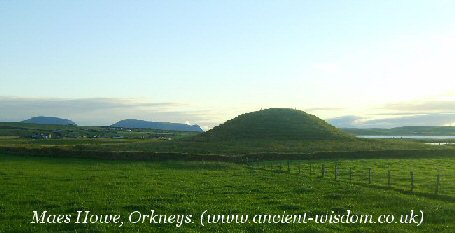
It is proposed that
these mounds were a symbolic representation of the primal 'Mound of
Creation', rising from a watery mythological past. The Maes Howe
mound above is connected to the ceremonial landscape of the Orkneys
through the close proximity of the Stennes circle, and within sight
of that, the larger Brodgar circle, a combination which appears to
have a common thread at several other western European megalithic
complexes: (Avebury/Silbury Hill, Gavr'inis-Er-Lannic, Zambujeiro-Almendres,
Ggantija/Xaghra). Regional variation on this theme has resulted in
several combinations: In Ireland, Tara Hill shows the same features
combined in the same ceremonial setting, only with the mound in the
centre of the circle, Newgrange mound was built over an existing
Stone circle, and Avebury has two circles built within it. This
association of a prominent mound and associated circle/s can be seen
to be one of the basic features of several of the (contemporary
Neolithic) western-European ceremonial arenas. There are several
other more specific similarities which suggest a contact along the
Atlantic coastline of Europe between these civil-scale ritual
complexes.
(Similarities between Neolithic
Western-European Complexes)
(The
Mound Builders of North America)
|
Similarities Between European Passage-Mounds: |
While the outsides of many
passage-mounds have suffered from the fancies of the restoration
team, the insides have remained relatively untouched, and it is here
that we find several structural and artistic similarities between the European
passage-mounds. The following examples include some of the
largest and well known passage mounds in Europe.
Similarities in Design:
Raised internal chambers: Both the Newgrange and
Gavr'inis passage-mounds have artificially raised internal chambers.
In Newgrange, this elevation of the chamber reduces the entry of light
into the central chamber as the following diagram illustrates.
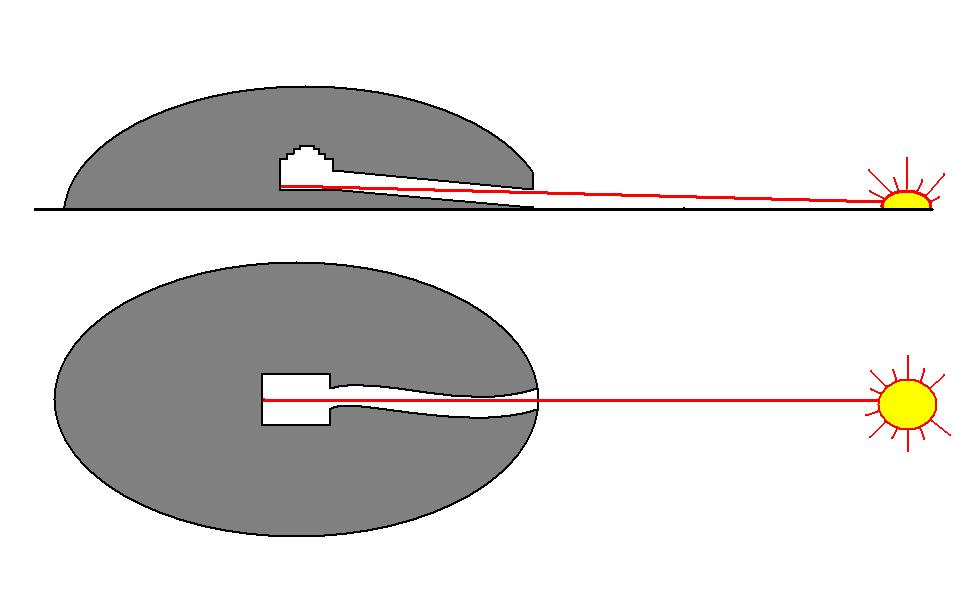
At Newgrange, the light-box
is used along with other construction features (such as the
passage narrowing and undulating along it length and a
subtle increase in altitude towards the centre), which
combine to focus the rays of the
sun along the passage into a small, narrow beam of light,
which is visible for only a few minutes on a few days
around the winter solstice. As well as illustrating the
astronomical nature of the structure, the inclusion of such
a specific set of designs highlights the importance of accuracy to the builders.
|
'Light-Boxes':
Light-Boxes
are a construction feature specific to European passage-mounds.
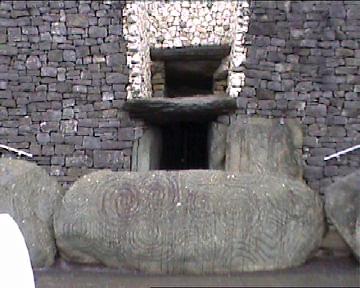
The incorporation of light boxes into megaliths is one of the
few direct proofs of the link between megaliths and astronomy, as
their purpose was the manipulation of light into the passage mounds at
certain times of the year only. In Egypt, the earliest pyramids all contain
'polar-shafts', and on Malta, the 'Temples' were orientated towards the
solstices and equinoxes. In Britain, all the known passage-mounds
containing light-boxes were also aligned with solar events, (i.e. the
equinoxes or solstice)
-
Newgrange
- Ireland, (Winter Solstice, Lunar standstill)
-
Crantit
Tomb, Orkneys - (Start and end of winter..?)
Carrowkeel
(Cairn-G), ( Possibly
Cairn-H),
Ireland, (Summer and winter solstice, Lunar standstill)
Maes Howe - Orkneys, (Winter
solstice).
Bryn Celli Ddu - Anglesey, (Summer
solstice, Lunar standstill)
(More about Light-boxes)
|
Newgrange, Knowth, Dowth, Fourknocks and Maes-Howe all have cruciform chambers
inside
(And
the
internal layout of the Maltese temples also show strong
similarities).
The exact function/purpose of the cruciform design is still unknown,
but there are some common threads which may offer a clue as to
their original purpose.
European Cruciform chambers are frequently
associated with astronomical orientation.They are distinguished by a long
passage leading to a central chamber with a corbelled roof. From this,
burial chambers extend in three directions, giving the overall
impression in plan of a cross shape layout. Some examples have further
sub-chambers leading off the three original chambers. The network of
chambers is covered by a cairn and lined outside with kerb-stones.
A common trait is megalithic art
carved into the stones of the chambers' walls and roofs. Abstract
designs were favoured, especially spirals and zig-zags.
Examples are
Newgrange ,
Knowth,
Dowth and Fourknocks
(amongst many) in Ireland,
Maes howe in
Orkney, 'La Hougue Bie' on Jersey and Barclodiad-y-Gawres in Anglesey,
and the Maltese temples.


Newgrange (left), with three stone bowls, one in
each recess, Maes Howe (right).
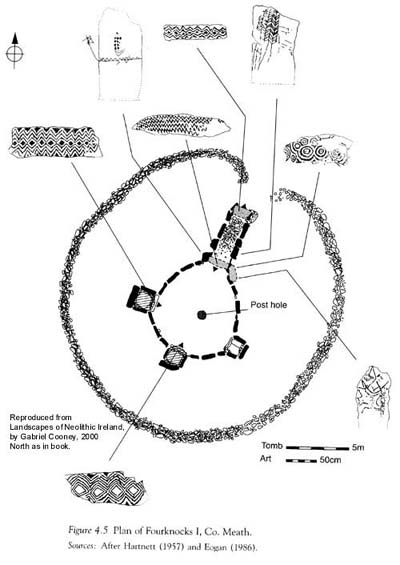
Fourknocks, Ireland, with cruciform chamber and
'crossed' lintel-stones.
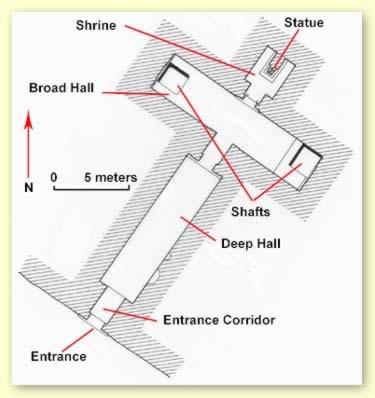
Egyptian Cruciform Chambers.
The
tomb of Ahmoset (left); 'Fanbearer on the King's Right Hand',
'Steward of the Estate of Akhetaten' and 'Royal Scribe' at
Akhetaten' during the Amarna Period, was also cruciform in
shape. It is interesting to note that here too a bowl was present.
'The shrine opening from the very back of the
broad hall on the center axis of the tomb was undecorated, though a
seated statue of the tomb owner was cared at is back. However, this
is now badly mutilated. A libation basin was cut into the floor in
front of the statue'.
(Ref:
http://www.touregypt.net/featurestories/Ahmoset.htm )
The same cruciform symbolism is seen around the ancient world,
where it is often associated with the 'World-Tree' or the Sun.
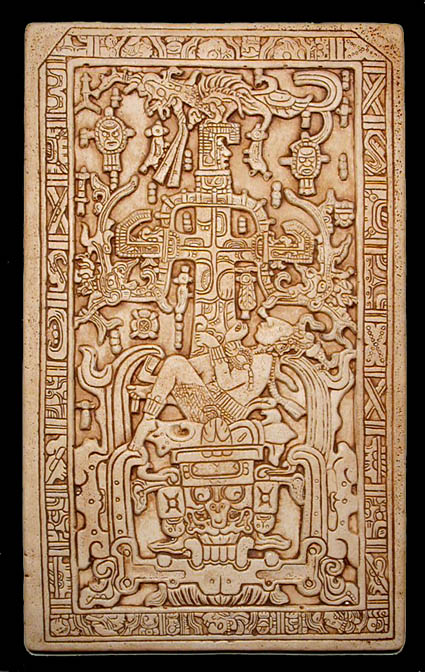

Palenque, Mexico (left), Celtic cross (right).
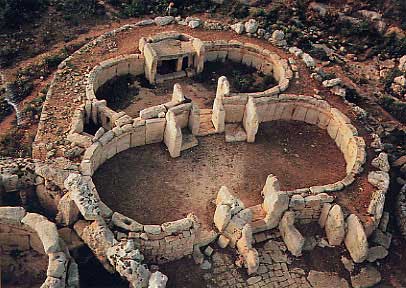
The Maltese temples are believed to have been
originally covered over, which would have rendered them with
essentially the same exterior design as the other other European
passage mounds.
The Maltese temples, whilst retaining a essentially
internal cruciform shape, are rounded in the same way as the
earth-mother figurines found across the island. It has been suggested
that this interior design can also been seen at other prehistoric
constructions such as Skara Brae, on the Orkneys and over 60 Neolithic
houses across the British Isles.
(5)
(More about the
Earth-mother-earth)
It has been noted that the cruciform chambers of several
large, prominent passage mounds contain large, stone-cut 'offering'-bowls or
'libation-bowls'.
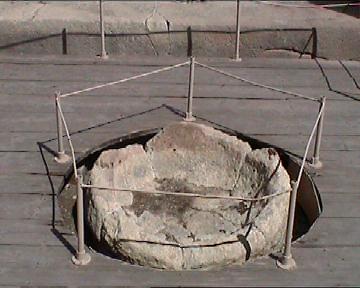

Above left and right - Hal
Tarxien, Malta.
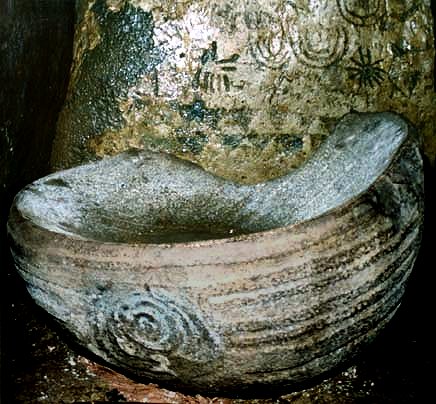
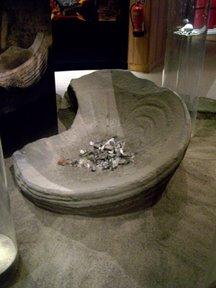

Knowth (left), Newgrange
(centre) with one in each recess, and Dowth
(right).
The bowls at the Boyne valley (above) were found to have
funerary deposits in them, although it is not clear if that was what their
original purpose was. In the case of the Dowth bowl, it has been shown from
its dimensions that the passage (and therefore the mound), had to have been
built around it. The engravings on both the Newgrange and Knowth bowls
suggest that they are contemporary too.
(More about the Boyne-valley
complex)
Spiral Art and Passage-mounds:
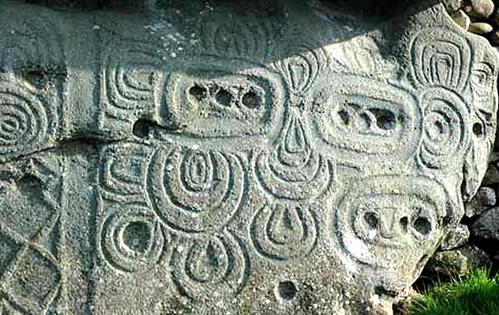
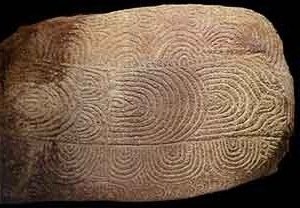
The Kerbstones from Newgrange K-52 (left) and
Gavr'inis, France, right share several
symbolic designs.
Stone SE4 at Knowth has a series of
crescents running down the side, a design similar to that found on the
rear stone inside Le Table des
Marchands' passage mound, (nearby and contemporary with
Gavr'inis).
It has also been noted that there are several distinct similarities between
the art of the
Boyne Valley complex and the Orkneys
complex as
the following pictures illustrate.
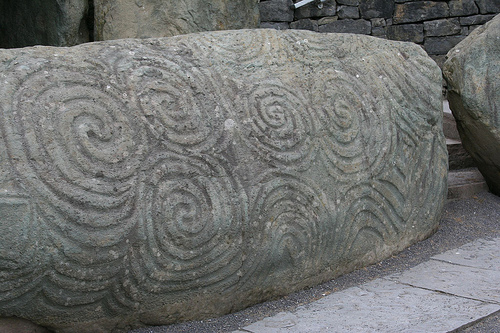
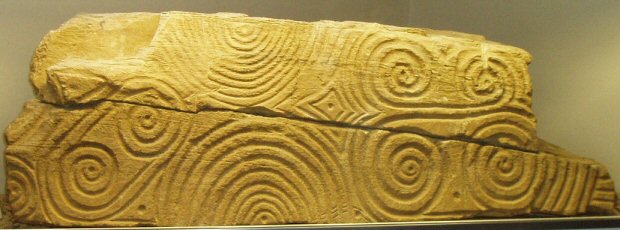
Newgrange kerbstone (left), and the 'Westray'
stone, Orkneys (right).
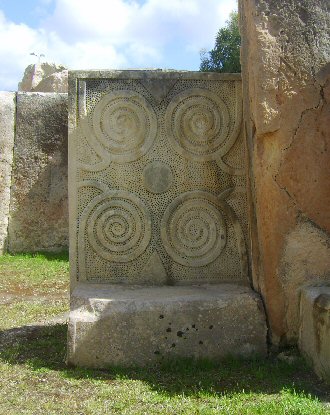
Similar Art can be seen on Malta. The
contemporary images of the prehistoric Maltese temples show them as
being covered over, which, when combined their internal cruciform
design and the fact that they were generally orientated to the same
moments of the year reveals a set of common themes with the western
European passage-mounds.
|
Passage-mounds and Astronomy: |
The
following table
supports the idea that there is an intimate relationship between passage-mounds and
the astronomical orientation of their
passages.
|
Name of Mound |
Orientation |
| |
|
|
Carrowkeel,
Ireland (Cairn G). |
Summer solstice sun, Winter solstice moon. |
|
Dowth, Ireland |
Cross-quarter
day sunset, and minor lunar standstill. |
|
Fourknocks, Ireland |
17� east of
true north (Unknown). |
|
Knocknarea, Ireland |
Unknown. |
|
Knowth, Ireland. |
Lunar minor standstill, Equinoxial. |
|
Loughcrew, Ireland |
Various orientations. |
|
Newgrange, Ireland |
Winter solstice sunrise. |
| |
|
|
'La Hougue Bie', Jersey. |
Equinoxes. |
|
Barclodiad-y-Gawres, Anglesey. |
(Coming Soon). |
| |
|
|
Gavrinis, France |
Winter solstice sunrise. |
|
Kerkado, France |
Midwinter sunrise. |
|
La Table des Marchands, France |
Summer solstice sunrise |
| |
|
|
Maes Howe, Scotland |
Winter solstice sunset, Venus |
| |
|
|
Brynn Celli Ddu, Wales |
Winter-solstice, Venus. |
| |
|
|
Commenda da Igreja, Portugal |
Pleiades rising. (Marks the start of
the agricultural year) |
|
Zambujeiro, Portugal |
Spring full moon 110�
- Alignment to Xarez. |
| |
|
|
Cueva
de Menga, Spain. |
Passage mounds orientated towards nearby 'Head'. |
| |
|
At 4,700 BC, The Kercado
passage-mound is one of the earliest examples in Europe. It was
carefully orientated towards the midwinter sunrise.
The Boyne-Valley passage-mounds.
The Boyne Valley complex have been shown to have been
built so as to be orientated and aligned amongst each other so as to
mark several important solar and lunar events. Combined with the
inter-visibility of structures at
Loughcrew and Tara hill, both of
which were important megalithic sites in their own right, and both of
which also contain astronomical markers, and we are able to begin to see
that there is no doubt that astronomy was important to the builders of
the large Irish passage-mounds of 3,200 BC. It is suggested that this
network of inter-visible sites would have operated like a giant
'calendar' for the inhabitants at the time. (1)
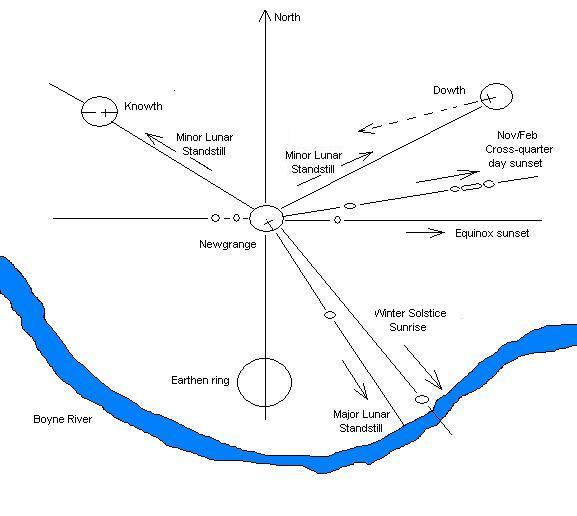
(More about Astronomy and the
Megaliths)
- (More about
the Boyne-valley complex)
|
Examples of Passage-Mounds: |
Examples of Passage mounds.
The passage mound structure varies from region
to region, whilst maintaining similarities in design, construction,
and art and presumably purpose.
|
French Passage-mounds:
Research in France has
revealed more than one building phase of passage-mounds in the Carnac region.
The Neolithic builders of 3,300 BC
absorbed the monuments from an earlier megalithic culture into their
own structures (from over a thousand years before).

Kercado passage mound, Carnac,
France. At 4,700 BC, this is one of the earliest in Europe.
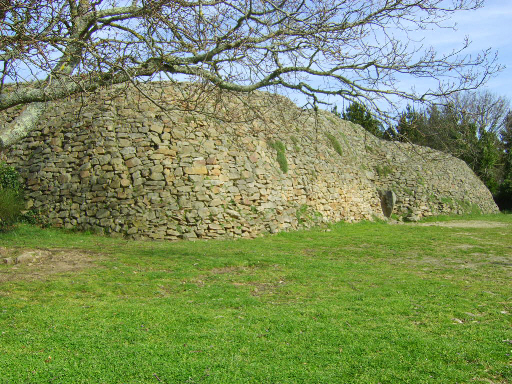
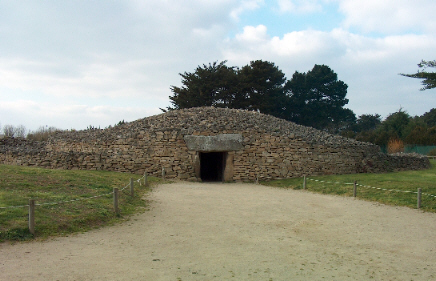
The capstones from
Gavr'inis (left),
Er-Grah, and
La Table des Marchands
(right), have all been shown to be parts of a earlier, single
monolith. The construction phase for these passage mounds is
dated at around 3,300 BC.
(More about the Carnac
complex)
|
|
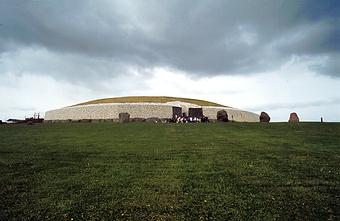 The
Irish passage mounds: Ireland has the
highest concentration of passage mounds, and they have been shown to
serve a specific function, namely that between them, they functioned
provided the locals with an accurate calendar of all the major solar
and lunar events throughout the year. (1) The
Irish passage mounds: Ireland has the
highest concentration of passage mounds, and they have been shown to
serve a specific function, namely that between them, they functioned
provided the locals with an accurate calendar of all the major solar
and lunar events throughout the year. (1)
The Irish passage mounds from the
Boyne valley region, were built at around 3,200 BC
(2), the same time as the French were building
theirs.
(Boyne-Valley complex)
|

Portuguese
passage-mounds: There are several passage mounds in
Portugal ranging from full sized, 50m diameter mound of
Zambujeiro to the more frequent but smaller mounds such as the
Orca mounds by the Mondego river.
The Portuguese passage
mounds present themselves as a unique hybrid of both dolmen
and passage-mound, with several of them having never been
fully covered.
Although there are several
different variations on the design of the Portuguese mounds,
they have a style that remains unique to themselves which is
that the stones supporting the capstones (invariably between 7
and 9), are placed with the front stones seemingly resting on
the larger stones at the rear of the chamber. This style of
construction is not seen elsewhere in northern Europe where
the stones are placed upright independently of each other.
Another noticeable fact with
many of the Portuguese dolmens and Passage-mounds is that a
great many of them have the top-half of the stone on the N-E
of the chamber missing. (Pers. Obs.)
(Prehistoric Portugal) |
|
 Spanish
Passage Mounds: Spain has several
prominent passage mounds, including arguably the largest one
in Europe. Spanish
Passage Mounds: Spain has several
prominent passage mounds, including arguably the largest one
in Europe.
The
Cueva de Menga complex include three
substantial passage mounds.
Cueva de Menga is considered to be one of the largest
such structures in Europe. It is twenty-five metres deep, five metres
wide and four metres high, and was built with thirty-two megaliths, the
largest weighing about 180 tonnes.
The entrance to the dolmen faces the
anthropomorphic Pena de los Enamorados in the distance.
(More
about Cueva da Menga complex)
|
Gallery of Passage Mounds: Quick Links.
|
|
 |
 |
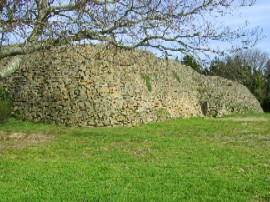 |
|
| |
La Table des Marchands, France |
Kerkado, France |
Gavrinis, France |
|
| |
|
 |
|
|
| |
|
Hougue Bie, Jersey. |
|
|
| |
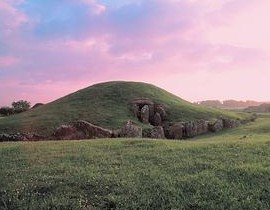 |
 |
 |
|
| |
Brynn Celli Ddu, Wales |
Cueva
de Menga, Spain |
Maes Howe, Scotland |
|
 |
 |
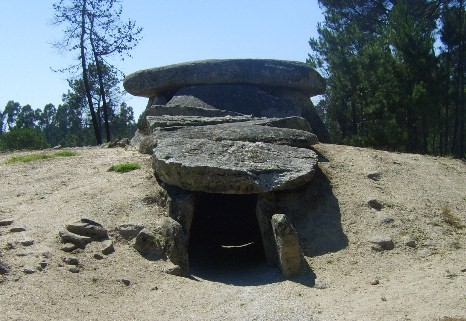 |
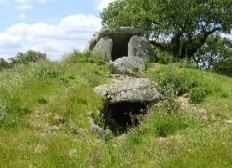 |
 |
|
Anta da Arcainha, Portugal. |
Tapadao, Portugal |
Orca da Lapa, Portugal |
Anta Grande do Igreja da Commenda, Portugal |
Zambujeiro, Portugal |
 |
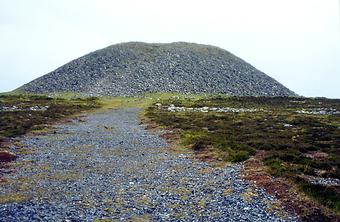 |
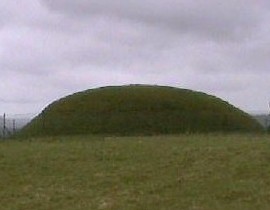 |
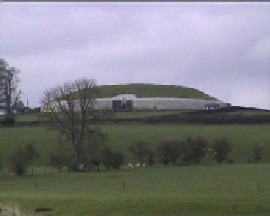 |
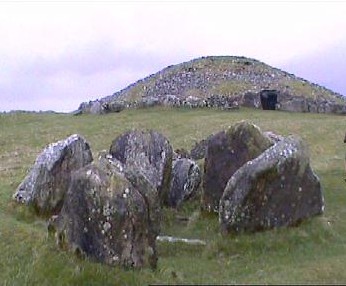 |
|
Mound of Hostages, Ireland |
Knocknarea, Ireland |
Fourknocks, Ireland |
Newgrange, Ireland |
Loughcrew, Ireland |
| |
 |
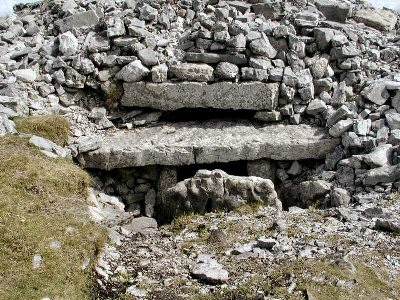 |
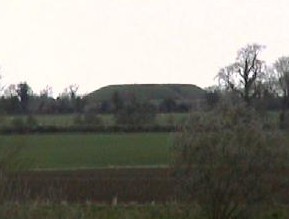 |
|
| |
Dowth, Ireland |
Carrowkeel |
Knowth, Ireland. |
|
|
































 Spanish
Passage Mounds: Spain has several
prominent passage mounds, including arguably the largest one
in Europe.
Spanish
Passage Mounds: Spain has several
prominent passage mounds, including arguably the largest one
in Europe. 








